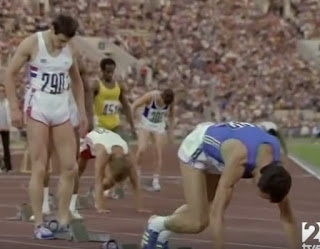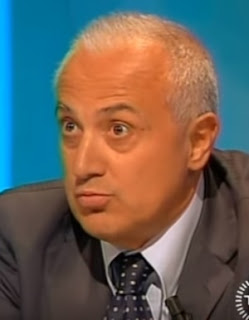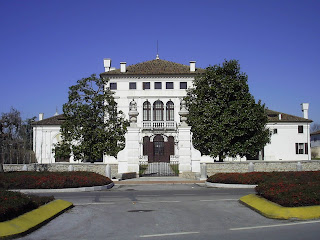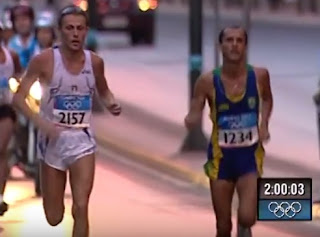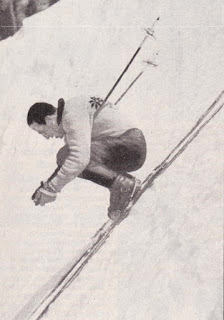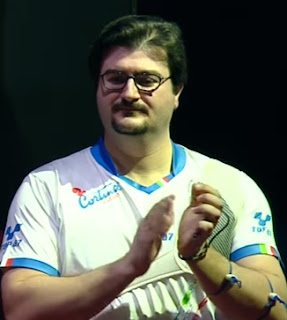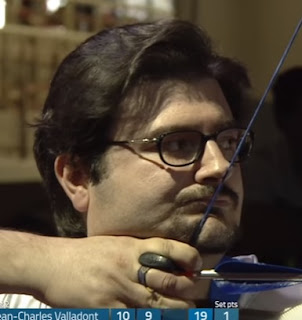Athlete who made his fortune from famous disqualification
 |
| Dorando Pietri with the silver cup presented to him by Queen Alexandra |
The athlete Dorando Pietri, who found fame and fortune after
being disqualified in the 1908 Olympic marathon, was born on this day in 1885
in Mandrio, a hamlet near Carpi, in Emilia-Romagna.
In an extraordinary finish to the 1908 race in London, staged
on an exceptionally warm July day, Pietri entered the White City Stadium in
first place, urged on by a crowd of more than 75,000 who were there to witness
the finish, only for his legs to buckle beneath him.
He was helped to his feet by two officials only to fall down
four more times before he crossed the finish line. Each time, officials hauled him to his feet
and walked alongside him, urging him on and ready to catch him if he fell. The final 350 yards (320m) of the event
accounted for 10 minutes of the two hours, 54 minutes and 46 seconds recorded
as his official time.
Eventually, a second athlete entered the stadium, the
American Johnny Hayes, but Pietri had staggered over the line before he could
complete the final lap.
The American team was already unpopular with the British
crowd, partly because of a row about a flag at the opening ceremony. They lost
even more support after they lodged an objection to the result.
Pietri, a small man of 5ft 2ins who looked older than his
22 years, was hailed for his pluckiness by the White City crowd, who felt he
deserved the gold medal. But the Games
organisers were obliged to uphold the American complaint, on the grounds that
the Italian had received assistance.
 |
| Pietri races ahead of the field in the 1908 Olympic Marathon |
The outrage at this decision extended even as far as the
British Royal Family. Queen Alexandra
had taken a particular interest in the race, even arranging for the start line,
originally set for a street outside Windsor Castle, to be moved inside the
castle grounds so that her children could watch. This extended the distance to
26 miles 385 yards, which has remained the official distance for marathons ever
since.
Inside the stadium, with the finishing line placed directly
in front of the Royal Box, Queen Alexandra is said to have been so thrilled to
see Pietri stagger across the line and be acclaimed the winner that she joined
the applause of the crowd by banging her umbrella on the floor of the box.
When she learned he had been disqualified, the story goes
that she was so disappointed on his behalf that she insisted his efforts be
recognised and arranged for a silver and gilt cup to be inscribed, which she
presented to him during the closing ceremony.
This gesture caught the public imagination to such a degree
that the Daily Mail began a fund for him, which the celebrated author Arthur
Conan Doyle, who had been commissioned by the newspaper to write a report of
the race, launched by donating five pounds.
The Mail told its readers that money raised would help
Pietri, a pastry chef by trade, to open a bakery in Carpi. In the event, the appeal realised £300,
which in 1908 was a sum comparable with more than £28,000 today.
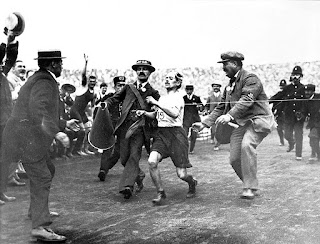 |
| Pietri is helped across the line at the finish of the race |
With that money and his subsequent earnings as a
professional – he was invited to compete in lucrative races all over the world,
including a 22-race tour of the United States – he was able eventually to open
an hotel.
Apart from making his fortune, cashing in on celebrity
status that extended even to having a song written about him by Irving Berlin, Pietri
was able to use his American tour to remove any doubt that he was a worthy
winner in London.
In a rematch staged over 262 laps of a special track built
at Madison Square Garden in New York in November, 2008, in front of a 20,000
crowd, Pietri defeated Johnny Hayes, repeating the win four months later. In all the Italian won 17 of the 22 races on
the tour.
Pietri retired from competition in 1911, after a career
lasting just seven years, which had been interrupted by two years of national
service.
Sadly, the Grand Hotel Dorando in Carpi was not a success
and in time was closed, after which Pietri moved to the Ligurian resort of San
Remo, where he ran a taxi business until he died in 1942, having suffered a
heart attack.
 |
| The Piazza Martiri is Italy's third largest square |
Travel tip:
Carpi, situated 18km (11 miles) north of Modena in the
Padana plain, became a wealthy town during the era of industrial development in
Italy as a centre for textiles and mechanical engineering. Its historic centre,
which features a town hall housed in a former castle, is based around the
Renaissance square, the Piazza Martiri, the third largest square in Italy.
Italy’s national marathon has finished in Carpi in 1988 in honour of Dorando
Pietri, who is also commemorated with a bronze statue by the sculptor
Bernardino Morsani, erected in 2008 on the 100th anniversary of the
London Olympic marathon, at the junction of Via Ugo da Carpi and Via Cattani,
about 2.5km (1.5 miles) from the centre of the town.
 |
| Luxury yachts in the harbour at San Remo |
Travel tip:
San Remo, the main resort along Liguria’s Riviera dei Fiori –
Riviera of Flowers – is a town steeped in old-fashioned grandeur with echoes of
its heyday as a health resort in the late 19th and early 20th
centuries, with broad streets lined with palm trees and luxury villas. The harbour is still filled with expensive
yachts and the casinos attract wealthy clientele. San Remo also has an old town
of narrow streets and alleyways and is famous as the home of an annual pop
music contest, the Sanremo Festival, where winning is still a considerable
career advantage for up-and-coming Italian performers.






